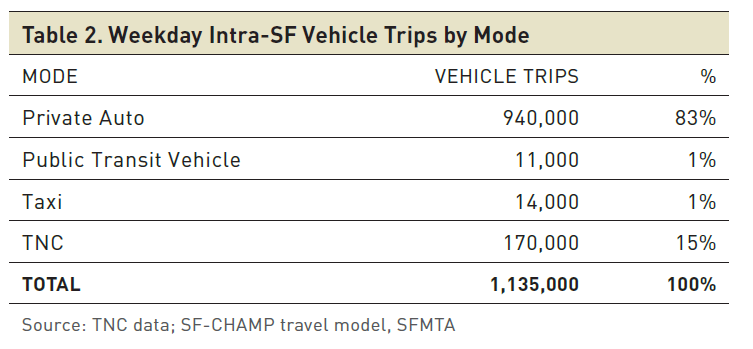In the span of about 7 years, app-based ride-hailing (i.e. Lyft and Uber) has gone from non-existent to ubiquitous in major metro areas. But how are these services affecting important aspects of our transportation system like congestion, public transit, and vehicle emissions?
The San Francisco County Transportation Authority (SFCTA) made a big first step last week towards answering these questions. The agency released data showing when, where, and how many rides start and end within San Francisco.
These statistics are important because passenger vehicles are the largest source of climate emissions in California, a major source of air pollution, and play a central role in our transportation system, which greatly affects social equity. If ride-hailing continues to grow, it has the potential to positively or negatively impact many aspects of transportation, including the reliability of public transit; costs of travel; extent of air pollution and climate change; safety of pedestrian and vehicular travel; and accessibility, type, and quality of jobs.
Lyft’s recent commitment to provide 1 billion miles of travel in autonomous electric vehicles powered by 100 percent renewable energy by 2025 is an encouraging step towards a positive future of app-based travel.
Some of the report’s findings are what you’d expect
Not surprisingly, the number of rides within San Francisco peaks in the heart of downtown on Friday and Saturday nights. During the week, ride-requests are at their highest during the morning and evening commutes. More rides are requested after work than before work. Interestingly, more rides are also requested as the work week progresses, #fatigue?

SFCTA developed a website to visualize when and where rides are starting and ending in San Francisco. It’s pretty cool, especially if you’re familiar with the city.
Switching from pick-up to drop-off location (see gifs), gives a rough sense of where people are traveling to and from, i.e. commuting to downtown in the morning and out of downtown in the evening. SFCTA’s data doesn’t correlate the pick-up and drop-off locations of individual rides, but the aggregate data still suggests these trends.


Other findings are less expected
The most surprising numbers from SFCTA’s report are the sheer volume of rides being given by Uber and Lyft: more than 150,000 intra-San Francisco trips per day, which is roughly 15 percent of all vehicle trips taken within the city and more than ten times the number of taxi trips.

The SFCTA study only considered trips originating and ending within San Francisco. So, there are actually many more Uber and Lyft trips being taken to or from the city.
Another interesting finding: approximately 20 percent of the miles traveled by Uber and Lyft drivers in San Francisco are without a passenger. These out-of-service miles (also known as “deadheading”) are actually lower for Uber and Lyft than taxis, which drive 40 percent of their miles without a customer. More Ubers and Lyfts on the road compared to taxis mean less distance is traveled between drop-offs and pickups.
What’s the big deal?
If you asked, “Don’t Uber and Lyft already have this data?” You’d be right. They do. So does the California Public Utilities Commission (PUC), which oversees transportation network companies (TNCs) – the policy term given to Uber and Lyft.
But the TNCs and PUC denied requests for data, so SFCTA partnered with Northeastern University to indirectly measure it themselves. Uber and Lyft oppose sharing data that could reveal aspects of their market share, such as where they dispatch drivers and pickup riders. Because there are only two main ride-hailing companies, either company could just subtract out their own numbers from aggregate data sets to get a sense of what the other company is doing.
The companies have a competitive history, but the need for this type of data will only increase as they provide larger fractions of vehicle trips, especially if projections materialize for ride-hailing with self-driving cars. Without data, it will be difficult to justify the potential safety, mobility, and emissions benefits (or consequences) of self-driving vehicles.
It’s fair to ask whether Uber and Lyft should share data not necessarily required by other fleets. A notable exception is the New York City Taxi and Limousine Commission, which approved standards earlier this year requiring TNCs to report trip information taxis were already required to share.
Even simple metrics such as the types of vehicles in a fleet (electric, hybrid, conventional), as reported by taxis in San Francisco, are important pieces of information for local governments to address the climate and air quality aspects of transportation. As the saying goes, you can’t improve something that you don’t measure.
What’s next?
SFCTA’s findings raise many questions about what types of trips TNCs are replacing. Are they getting people out of personal cars or turning pedestrians into ride-hailers? Are they eroding public transportation or making it easier for people to get to the bus, MUNI, or BART? Are people taking solo rides or sharing trips via uberPOOL or Lyft Line?
Previous studies and those underway are attempting to answer these questions. But ultimately, data like those from SFCTA are critical for transportation planners and researchers to understand the impact of ride-hailing services today and how they can be used to improve, and not hinder, how we get around in the future. Decisions like expanding roads vs. setting aside land for public spaces or how to better serve a community with public transportation all depend on knowing when, where, and how many trips we’re taking, whether by foot, bike, car, bus, or train.

